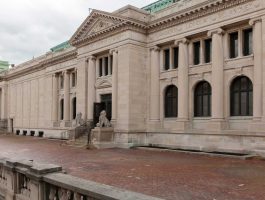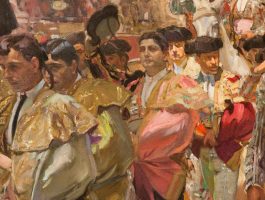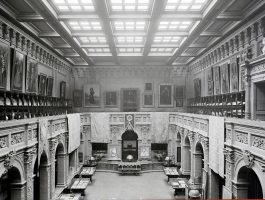The Ceramics Galleries offer visitors a unique opportunity to view seven centuries of the ceramic arts of Spain and Latin America, encompassing lusterware, faience or tin-glazed earthenware, burnished earthenware, and porcelain. Some of the finest examples to be found anywhere of the famous Islamic-influenced lusterware produced at Manises (Valencia) occupy pride of place in the first gallery. All of the major decorative styles and motifs from Islamic to Gothic can be found on the dozens of albarelos (pharmacy or drug jars), chargers, bowls, deep basins, and vases of the “golden” pottery. At the height of its popularity in the 14th and 15th centuries, Spanish lusterware with its lustrous metallic glazes was the most prized of all European ceramics. A broad array of pieces dating from the 15th through 18th centuries from Muel and Barcelona complete the presentation of lusterware. Additional Medieval ceramics include two marvelous plates (ca. 1500) from Seville in the cuerda seca technique decorated in the characteristic green, blue, ochre, and white glazes with images of a harpy and a dragon; as well as a large 15th-century jar from Teruel in Aragon decorated with heraldic devices and foliate designs in the typical green, black, and white glazes. Seville was also a major early center for the production of architectural tiles during the late Medieval period and the Renaissance. Dozens of representative examples are on exhibition, including 15th-century cuerda seca figural and Islamic-influenced interlacery tiles in matte glazes, along with 16th-century cuenca tiles in polychrome and luster glazes. Accompanying the ceramics in the first gallery are rare specimens of the Venetian-inspired enameled glassware produced at Barcelona in the 16th and 17th centuries, as well as 18th-century glassware from the Royal Glass Factory of La Granja.
The second gallery begins with 16th- and 17th-century polychrome painted flat tiles, an Italian technique introduced in Seville in the early 16th century by Francisco Nicoluso Pisano, and includes a tile panel with the image of St. Dominic made around 1622 from the workshop of Fernando de Valladares. An extensive collection of the famous tin-glazed earthenware from Talavera de la Reina and Puente del Arzobispo (Toledo) is the next focal point of the exhibition. On display are plates, pharmacy jars, vases, and bowls in cobalt blue-and-white and polychrome glazes produced from the 16th through18th centuries. Highlights include a large pharmacy jar with strapwork decoration produced in the late 16th century for the Royal Monastery of San Lorenzo de El Escorial; early 17th-century plates decorated in blue, orange, and manganese on white, one with a figure of a Flemish soldier and another with a scene of Jonah and the whale; and a large polychrome painted bowl with an uncommon scene of the roundup of bulls for a bullfight that was a gift from Joaquín Sorolla. The Hispanic Society also holds an important collection of blue-and-white and polychrome-glazed faience produced at the Royal Ceramics Factory of Alcora (Castellón) which gained fame in the 18th century for its meticulously painted and decorated wares. Numerous superb specimens of Alcora in a full diversity of forms and decorative styles are exhibited, such as plaques, sculptures, chargers, trays, bowls, pitchers, and mancerinas (trembleuses) for drinking chocolate. In the 18th century Charles III established the royal porcelain factories of Capodimonte (Naples) and Buen Retiro (Madrid). On view are finely painted shell-form snuff boxes in soft paste porcelain from Capodimonte, accompanied by plates with decoration inspired by Chinese export porcelain and impressive large vases and candelabra in the Neoclassical style from the Buen Retiro factory. Concluding the exhibition of Iberian ceramics are two panels of painted Catalan tiles, one illustrating the typical arts, crafts, and trades of the 18th century; and the other a humorous interpretation of the same tradition from 1903 by the famous Barcelona artist Ramón Casas which he titled The Advances of the 19th Century (Els adelantos del sigle XIX), a collection of 25 tiles offered to the subscribers of his art journal Pel & Ploma.
The second gallery also features rare examples of Latin American ceramics, such as the earliest tin-glazed earthenware widely distributed in the Americas. Produced in the late 15th and early 16th centuries, it has been known since the 1970s as San Juan Polychrome based on archaeological fragments discovered in what was the indigenous barrio of San Juan Moyotlan in colonial Mexico City. The Hispanic Society is one of the few museums in the Americas where examples of the black, red, and slip decorated burnished pottery known as búcaros de Indias can be found on exhibition. Produced in the 17th and early 18th centuries at Tonalá (Guadalajara, Mexico) and Santiago (Chile), this fascinating pottery was esteemed for the aromatic qualities of its clay and was among the most highly prized ceramics in the collections of European nobles of the era. In the 17th century the consumption of small pieces of búcaros became fashionable among the women of the Spanish aristocracy, and the habit may have contributed to the untimely death of Marie Louise of Orléans, Queen consort of King Charles II of Spain. Especially noteworthy are the unique unglazed black clay sculptures of a fish and a turkey, paired with handled cups with matching sculptural decoration on their interiors.
Earthenware from Puebla de los Angeles (Mexico) completes the exhibition of Latin American ceramics. The predominantly cobalt blue-and-white glazed Talavera Poblana was heavily influenced in the 17th and 18th centuries by Chinese porcelains, both in form and decoration. The masterpiece of the collection is a large handled jar or vase from the mid-17th century, finely decorated with Chinese and European figures, triumphal chariots, and a bullfight scene, that is signed “he” and attributed to Damián Hernández. From the early 20th century are rare examples of the work of Enrique Luis Ventosa executed in new decorative styles: Art Nouveau, Chinese, and Mixtec, the latter inspired by the Codex Zouche-Nuttal. Puebla also was justly famous for the production of architectural tiles, typified by a large tile panel of the Virgin of the Immaculate Conception from the late 18th century that completes the exhibition.




